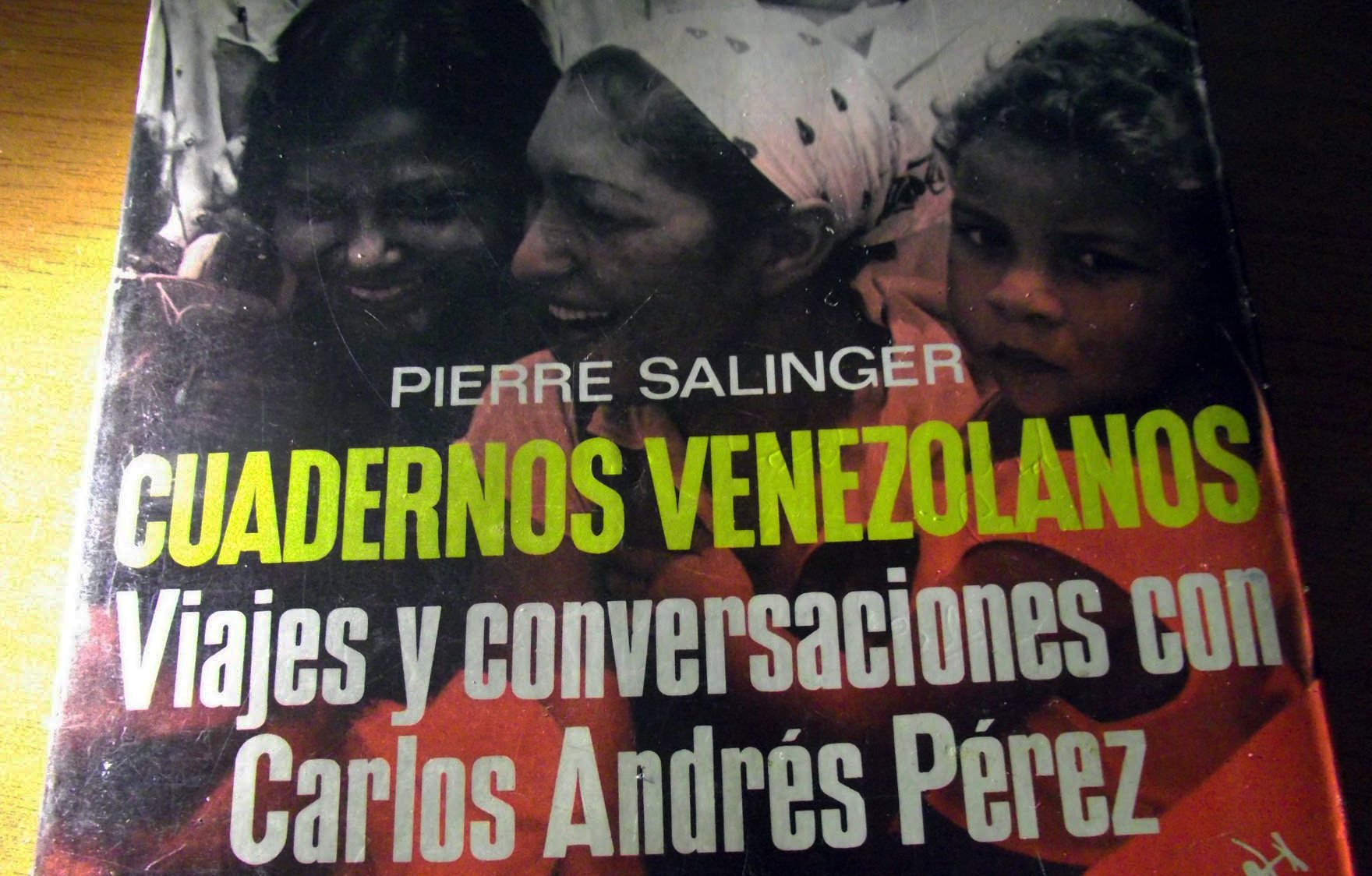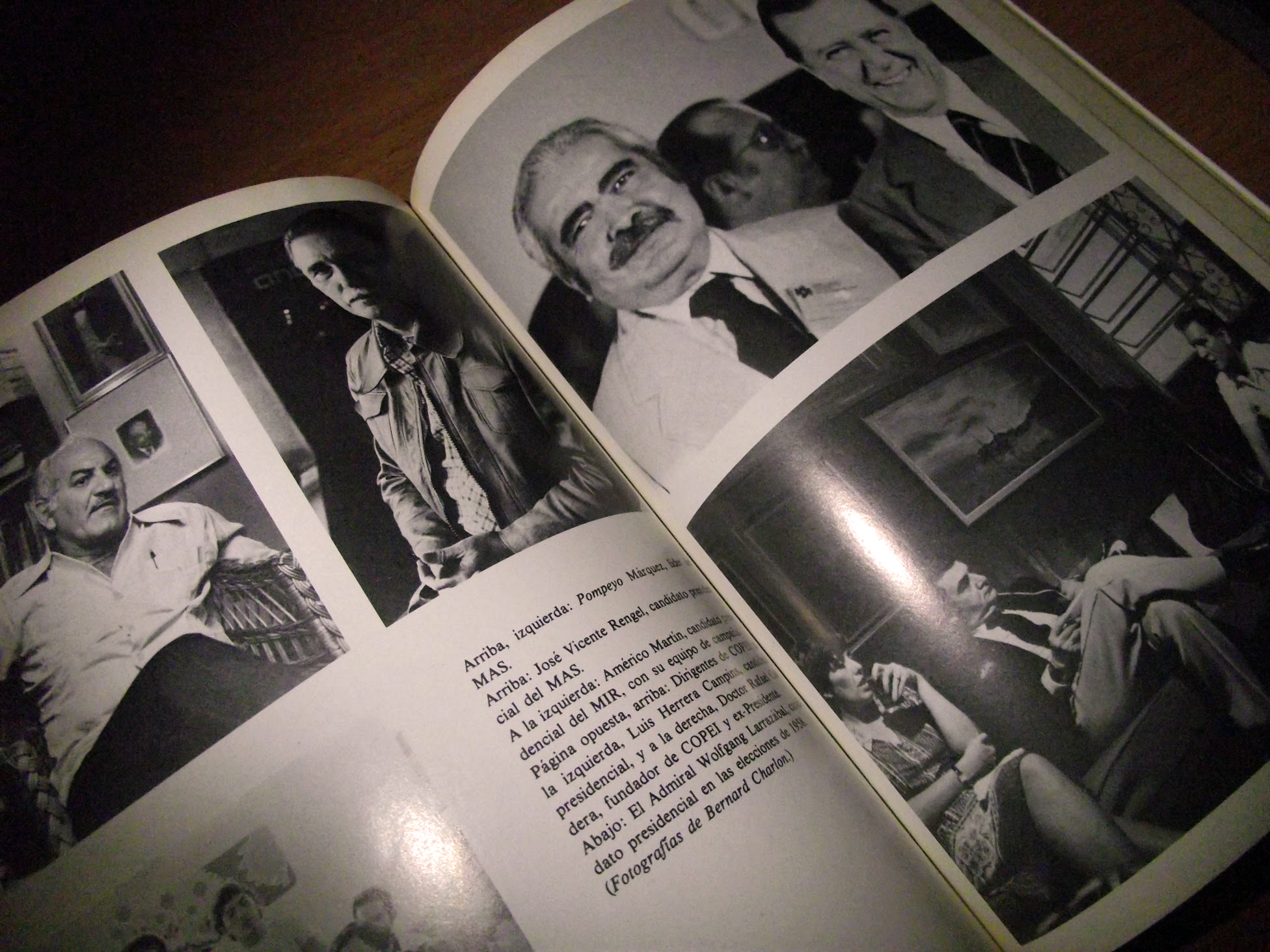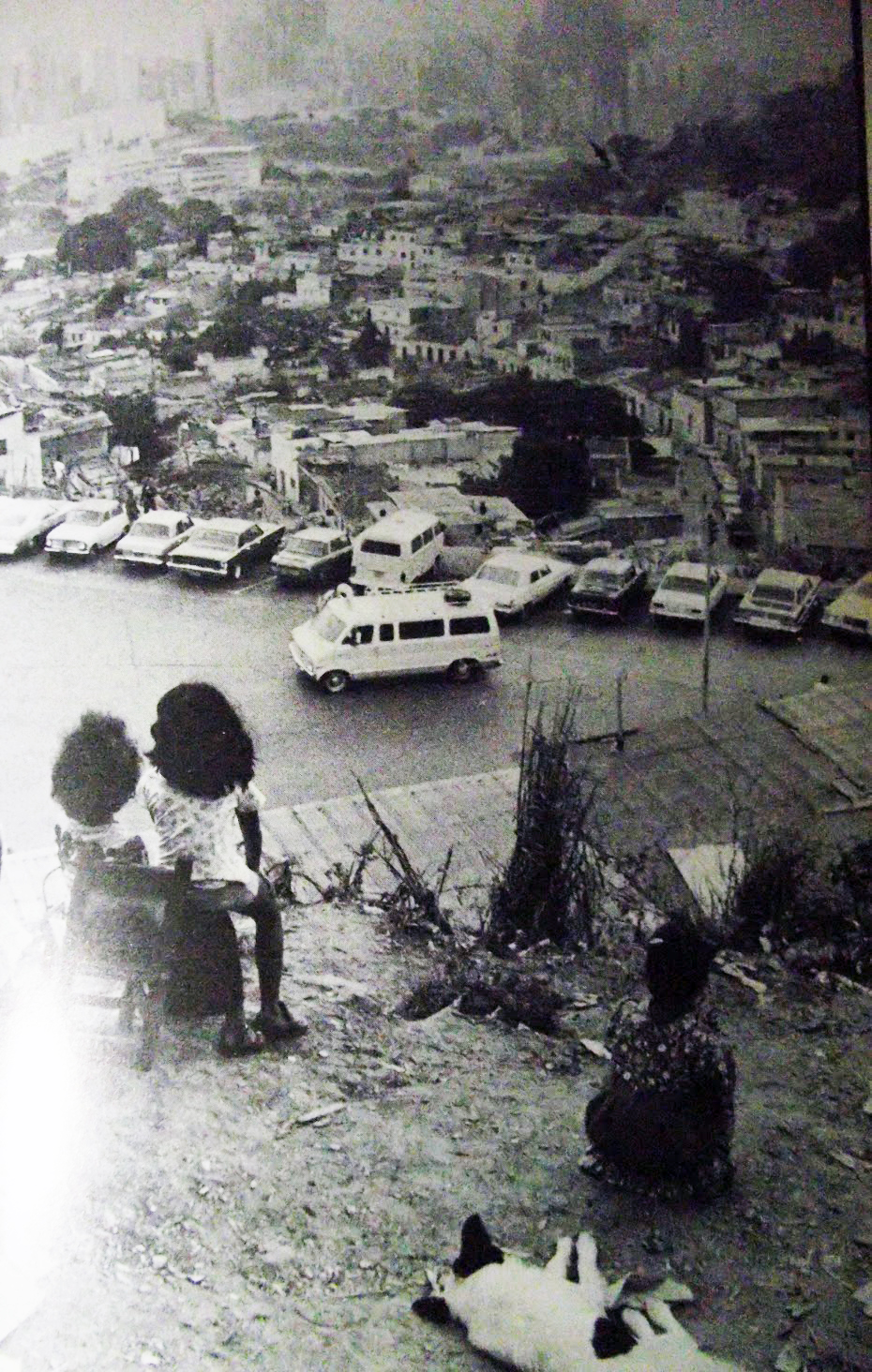Adeco Archaeology
A walk down petro-populism memory lane, through the eyes of a Kennedy-loving gringo.


I don’t get it. I have lived over half of my life under chavismo, and there are many things I don’t get about how we got here. I don’t get why we didn’t have state elections until 1989 nor I get who thought by any measure that Alfaro Ucero was presidential material. I simply don’t.
But, I like to dig around. Get my hands dirty in this puzzle we all live in. Usually, I don’t get many answers but sometimes, I find a real nugget. A few years back, while looking through my grandparents’ old stuff, I found one: a Spanish edition of Venezuelan Notebooks: Travels and Conversations with Carlos Andrés Pérez by journalist Pierre Salinger.
 I knew my grandparents were active members of Acción Democrática back in the day. Through the years I found miscellaneous Adeco kitsch: Luis Piñerúa’s 1978 election manifesto, an ashtray with Lusinchi’s face (probably not the smartest giveaway) and the iconic CAP doll from the ’88 campaign. But this book was in a completely different league.
I knew my grandparents were active members of Acción Democrática back in the day. Through the years I found miscellaneous Adeco kitsch: Luis Piñerúa’s 1978 election manifesto, an ashtray with Lusinchi’s face (probably not the smartest giveaway) and the iconic CAP doll from the ’88 campaign. But this book was in a completely different league.
Published in Spanish by Seix Barral, Salinger says he wants to introduce CAP to US readers and has very little to offer a Venezuelan audience. Instead, for me, the book is the perfect dissection of an era I had little to no mental image of, besides two broad, polarized narratives with very little common ground in-between.
Salinger gives us the contemporary view of the period in the first half of Carlos Oteyza’s documentary, Carlos Andrés Pérez: 2 Intentos.
The book is set in la Venezuela Saudita, in all its glory. This is a time when, according to Salinger, the country was making $10 billion a year in oil revenues (around $37 billion in today’s money) to spread between just 14 million people. The book was written in 1978, exactly mid-way between the fall of Marcos Pérez Jiménez and the rise of Hugo Chávez.
The book is the perfect dissection of an era I had little to no mental image of, besides two broad, polarized narratives
From page one, Salinger portrays Carlos Andrés as a larger-than-life figure. A relentless, charismatic leader who travels around the country and the world dedicating every second of his time and every bit of his soul working for Venezuela.
“One day,” , Salinger writes “he thinks over if a new slaughterhouse should be built in Achaguas and the next day he plays a pivotal role helping President Carter to get the US senate approval on the Panama Canal treaties.”
But this is not a completely one-sided piece. He treats CAP’s popularity with cautious sympathy, hinting at a syncretism between the cults of personality from the past and present-day populist petro-democracy. In the paragraph quoted above he adds “(…) Venezuela has changed. The dictators are a thing of the past, but this modern Presidency with its democratic legitimacy and endeavors is still too reminiscent of the old caudillos.”
And, as his aides gather bagfuls of little notes requesting favors from the people he meets (plus ça change…) el hombre que camina himself wonders what will people ask him next, musing that “the problem with the people is that the more you give to them, the more they want.”
The book follows CAP as he goes around around and intersperses that with his life story. It’s also peppered with interviews with politicians and public figures, but very few direct quotes.
Many of the interviewees have fallen into obscurity (David Morales Bello, anyone?), while others are somewhat expected closed ones that time have made legendary or even infamous: Ramón J. Velásquez, Enrique Tejera Paris, Gonzalo Barrios, Ramón Escovar Salom, and Simón Alberto Consalvi, to name a few.
 There are also a couple of notable historical characters whose first-hand accounts are seldom available and of great value, such as Luis Beltrán Prieto Figueroa talking about his beef with Betancourt and the ’68 election or Wolfgang Larrazábal on the difficult post-Pérez Jiménez years and confirming the famous maleta story.
There are also a couple of notable historical characters whose first-hand accounts are seldom available and of great value, such as Luis Beltrán Prieto Figueroa talking about his beef with Betancourt and the ’68 election or Wolfgang Larrazábal on the difficult post-Pérez Jiménez years and confirming the famous maleta story.
He treats CAP’s popularity with cautious sympathy, hinting at a syncretism between the cults of personality from the past and present-day populist petro-democracy.
But the most important interviews come from the chapter Salinger dedicates to CAP’s opposition which, copeyanos aside, is a who’s who of Venezuela’s Left at the time. There’s José Vicente (says CAP is a “great worker but lacks ideology”), Teodoro (“the problems that can’t be solved with money weren’t even studied”) and Copei chairman Godofredo González (“Our imports have soared at an accelerated pace while our exports have stalled”). Diego Arria and Américo Martín also show up. Salinger pretty much needed to interview Renny Ottolina, Tony Armas, and Maritza Salayero to fall into full Forrest Gump territory here.
Pierre Salinger is an interesting figure on his own right. Among other things he was White House Press Secretary during the Kennedy administration, campaign manager for Bobby Kennedy, vice-president of Continental Airlines, European correspondent for ABC News, plus he played Catwoman’s lawyer in the Batman TV series, so there’s that.
Yes, that’s him, and yes, that’s a picture of Nixon on his desk, as a in-joke for such Kennedy insider.

His career hit rock bottom in the mid-90’s when he presented a discredited online document as evidence that the TWA 800 Flight Explosion was caused by friendly fire and spent his final years in France, promising to move out of the country if George W. Bush became president. (Some people actually fulfill that promise. Who knew?)
Something else that plays on Salinger’s favor is being an outsider. For him, Venezuela is basically a case study about a model US-friendly democracy in Latin America, something akin to what JFK had aspired with his Alliance for Progress.
2 Intentos, by contrast, is relatively balanced if somewhat narrow in its view, but is all too easy to be blinded by images of a modern, shiny Caracas and ignore the visual footnotes involving growing barrios and political corruption but Salinger doesn’t have the emotional ties, much less the historical perspective.
Salinger is eerily prophetic in seeing through the mirage of Venezuela Saudita. He points out the lack of generational renewal within AD and COPEI and asks CAP about the party’s “growing conservative turn”. CAP considers the whole thing ridiculous, since he thinks the government’s massive social programs makes leftist movements redundant and regards AD and Copei essential for Venezuela’s democracy.
“Acción Democrática and COPEI obtain over 85% of the votes in a country with barely any abstention”, CAP proudly proclaims.
Salinger is eerily prophetic in seeing through the mirage of Venezuela Saudita.
But Salinger is smarter than that. In his epilogue, he’s still concerned about the management of oil revenue, and speculates that, within the next twenty years, a “third political force” from an united Left could threaten AD and Copei’s bipartisan government, comparing the myth of Venezuela’s democratic exceptionalism to pre-Pinochet Chile and pre-Perón Argentina and wonders if future generations will be available to keep the country’s budding democracy:
“If my judgment is correct and Acción Democrática’s policies continue to approach, unnoticeable but inevitably, to (…) COPEI’s, a rift between AD and the Left will grow, and AD will have to deal with an unified Left. Despite the efforts there’s a significant poverty in Venezuela, a bigger gap between the rich and the poor. If this situation rapidly progresses it will be a risk for future governments and Venezuelan democracy itself.”
The very last chapter exclusively deals with Salinger visiting the 23 de Enero slums. He notices the curious contrast of shacks made of cardboard and zinc with TV sets and stereo systems inside and highlights a sense of vital community life. The people identify with el barrio, but the government doesn’t get that. He also almost gets run over by a motorizado. I guess some things truly never change.
 His snippets from conversations with anonymous caraqueños, though few, are some of the most poignant moments in the book. “I used to earn 20 bolivars and we lived well, now we earn about 200 or 300 a day and we don’t have enough to go by”, someone says, sounding both quaint and relevant in today’s Venezuela. Although the epilogue ends in an upbeat note, the closing lines of the last chapter are more thought-provoking:
His snippets from conversations with anonymous caraqueños, though few, are some of the most poignant moments in the book. “I used to earn 20 bolivars and we lived well, now we earn about 200 or 300 a day and we don’t have enough to go by”, someone says, sounding both quaint and relevant in today’s Venezuela. Although the epilogue ends in an upbeat note, the closing lines of the last chapter are more thought-provoking:
“Every five years the different presidential candidates come to the barrio to shake the hands of its dwellers and present them their promises. Tomorrow, life will be better. But tomorrow never comes.”
I think this musiú has a thing or two to teach Oliver Stone about journalism…
Caracas Chronicles is 100% reader-supported.
We’ve been able to hang on for 22 years in one of the craziest media landscapes in the world. We’ve seen different media outlets in Venezuela (and abroad) closing shop, something we’re looking to avoid at all costs. Your collaboration goes a long way in helping us weather the storm.
Donate




